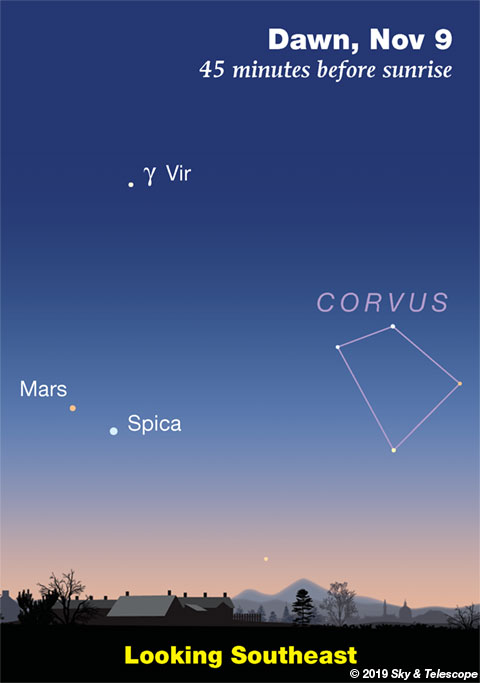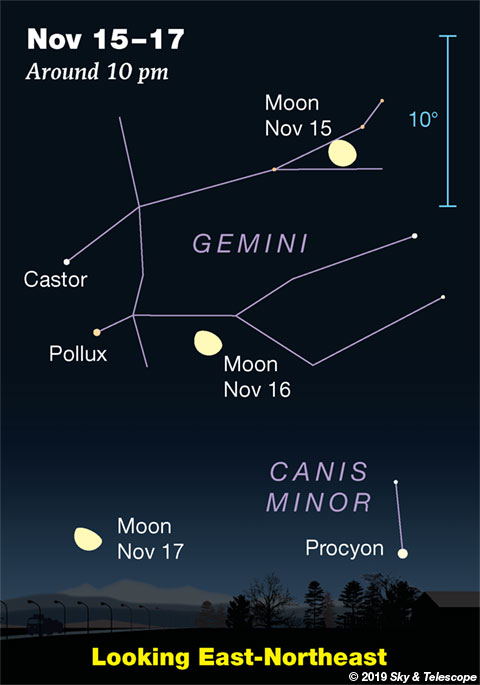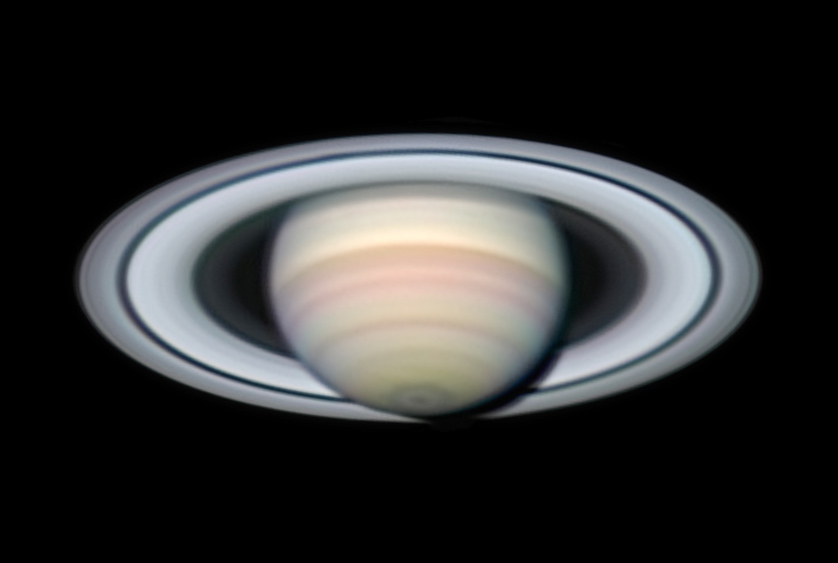
Friday, Nov. 8
• High above the gibbous Moon, pointing down at it, is the eastern edge of the Great Square of Pegasus. Continue down below the Moon and there's Diphda (Beta Ceti).
• This week, wintry Orion is clearing the eastern horizon by about 9 p.m. (depending on how far east or west you live in your time zone).
High above Orion shines orange Aldebaran. Above Aldebaran is the little Pleiades cluster, the size of your fingertip at arm's length.
And far left of Aldebaran and the Pleiades is bright Capella.
• The transit of Mercury is coming up in three days! Plan your observing now. See Monday below.
Saturday, Nov. 9
• In early evening, look high above the Moon for the Great Square of Pegasus through the moonlight. It's standing on one corner. The line from its top star through its bottom star points to the Moon.
• Happy 85th birthday, Carl Sagan (November 9, 1934 – December 20, 1996). If only.
Sunday, Nov. 10
• Sometime around 8 or 9 p.m., depending on where you live, zero-magnitude Capella will have risen exactly as high in the northeast as zero-magnitude Vega has sunk in the west-northwest. How accurately can you time this event? Astrolabe not required. . . but it might help.
Monday, Nov. 11
• Transit of Mercury. Tiny Mercury crosses the face of the Sun today — during morning for North America, midday in South America, and afternoon for Europe and Africa. The transit begins at 7:35 a.m. EST (12:35 UT) and ends at 1:04 p.m. EST (18:04 UT). At mid-transit, 15:20 UT, Mercury will be very close to the center of the Sun's disk. Of course you'll need a safe solar filter over the front of your telescope!
Map and details, or see the November Sky & Telescope, page 48. Also: see Citizen Science with the Transit of Mercury.
Cloudy? Watch Gianluci Masi's live observing session of the transit from the Virtual Observatory, starting at 12:30 UT (7:30 a.m. EST).
• Algol is at its minimum brightness, magnitude 3.4 instead of its usual 2.1, for about two hours centered on 11:46 p.m. EST. In its normal state Algol is equal in brightness to Gamma Andromedae, now above it.
Tuesday, Nov. 12
• Full Moon tonight and tomorrow night (because it's exactly full at 8:34 a.m. Wednesday morning EST). This evening the Moon shines in the east with the Pleiades to its upper left; binoculars will extract them from the moonlight if necessary. Orange Aldebaran hangs to the Moon's lower left. Way down below, Orion comes over the horizon.
Wednesday, Nov. 13
• Now the evening Moon shines close to orange Aldebaran. Above them are the Pleiades. Far down below is Aldebaran-colored Betelgeuse.
Thursday, Nov. 14
• Vega is the brightest star high in the west. Almost as high in the southwest (depending on your latitude) is Altair, not quite as bright.
Just right or upper right of Altair, by a finger-width at arm's length, is orange Tarazed. It looks like Altair's little sidekick but it's actually a much bigger and brighter star far in the background. Tarazed is about 360 light-years away, and it's 100 times as luminous!
• Algol is at minimum light for about two hours centered on 8:35 p.m. EST.

Friday, Nov. 15
• The waning gibbous Moon is high by late evening. It's in Gemini, in the dim feet of the Castor stick-figure as shown here. Much easier to spot are Castor and Pollux, far to the Moon's lower left.
• Vega is the brightest star in the west early on November evenings. Its little constellation Lyra extends to its left, pointing in the direction of Altair, the brightest star in the southwest.
Three of Lyra's leading stars, after Vega, are interesting doubles. Barely above Vega is 4th-magnitude Epsilon Lyrae, the famous Double-Double. Epsilon forms one corner of a roughly equilateral triangle with Vega and Zeta Lyrae. The triangle is less than 2° on a side, hardly the width of your thumb at arm's length.
Binoculars easily resolve Epsilon. And a 4-inch telescope at 100× or more should resolve each of Epsilon's wide components into a tight pair.
Zeta Lyrae is also a double star for binoculars; much tougher, but plainly resolved in any telescope.
Delta Lyrae, upper left of Zeta, is a much wider and easier pair.
Saturday, Nov. 16
• The waning gibbous Moon rises by 8 or 9 p.m. Once it's well up you'll see that it's in Gemini, with Pollux to its left and Castor above Pollux.
________________________
Want to become a better astronomer? Learn your way around the constellations. They're the key to locating everything fainter and deeper to hunt with binoculars or a telescope.
This is an outdoor nature hobby. For an easy-to-use constellation guide covering the whole evening sky, use the big monthly map in the center of each issue of Sky & Telescope, the essential guide to astronomy.

Once you get a telescope, to put it to good use you'll need a detailed, large-scale sky atlas (set of charts). The basic standard is the Pocket Sky Atlas (in either the original or Jumbo Edition), which shows stars to magnitude 7.6.
Next up is the larger and deeper Sky Atlas 2000.0, plotting stars to magnitude 8.5; nearly three times as many. The next up, once you know your way around, are the even larger Interstellarum atlas (stars to magnitude 9.5) and Uranometria 2000.0 (stars to magnitude 9.75). And read how to use sky charts with a telescope.
You'll also want a good deep-sky guidebook, such as Sue French's Deep-Sky Wonders collection (which includes its own charts), Sky Atlas 2000.0 Companion by Strong and Sinnott, or the bigger Night Sky Observer's Guide by Kepple and Sanner.
Can a computerized telescope replace charts? Not for beginners, I don't think, and not on mounts and tripods that are less than top-quality mechanically (meaning really heavy and expensive). And as Terence Dickinson and Alan Dyer say in their Backyard Astronomer's Guide, "A full appreciation of the universe cannot come without developing the skills to find things in the sky and understanding how the sky works. This knowledge comes only by spending time under the stars with star maps in hand."
This Week's Planet Roundup
Mercury is out of sight in the glare of the Sun.
Venus (magnitude –3.8, in Ophiuchus) is very low in the southwest during bright twilight. Look for it just above the horizon starting about 20 minutes after sunset. Don't confuse Venus with higher and easier Jupiter. The gap between these two planets is shrinking by a degree a day: from 16° on November 8th to 9° on the 15th. They'll pass 1½° apart on the 23rd and 24th.
Mars (magnitude +1.8, in Virgo) is low in the east-southeast in early dawn. This week it's several degrees from Spica, which is slightly brighter at magnitude 1.0. On the mornings of November 9th, 10th, and 11th, Mars is passing about 3° to Spica's upper left or left.
Don't be misled by Arcturus, much brighter, twinkling some 30° to their upper left.
Jupiter (magnitude –1.9, crossing from Ophiuchus to Sagittarius) is the creamy-white dot low in the southwest as twilight fades. It's between Saturn to its upper left and Venus to its lower right, creeping closer to the latter.

Saturn (magnitude +0.6, in Sagittarius) is the steady yellow "star" in the south-southwest during and after dusk. It's about 20° upper left of Jupiter.
Still below Saturn is the handle of the Sagittarius Teapot, highlighted by 2.0-magnitude Sigma Sagittarii (Nunki). Barely right of Saturn is the dimmer, smaller, triangular bowl of the Sagittarius Teaspoon.
Uranus (magnitude 5.7, in southern Aries) is well up in the east by 8 p.m. and highest in the south around 11.
Neptune (magnitude 7.9, in eastern Aquarius) is highest in the south in early evening. See our finder charts for Uranus and Neptune and Bob King's story on observing Neptune.
All descriptions that relate to your horizon — including the words up, down, right, and left — are written for the world's mid-northern latitudes. Descriptions that also depend on longitude (mainly Moon positions) are for North America.
Eastern Daylight Time (EDT) is Universal Time (UT) minus 4 hours. Eastern Standard Time (EST) is UT minus 5 hours.
![]() Audio sky tour. Out under the evening sky with your earbuds in place, listen to Kelly Beatty's monthly podcast tour of the heavens above. It's free.
Audio sky tour. Out under the evening sky with your earbuds in place, listen to Kelly Beatty's monthly podcast tour of the heavens above. It's free.
"The dangers of not thinking clearly are much greater now than ever before. It's not that there's something new in our way of thinking, it's that credulous and confused thinking can be much more lethal in ways it was never before."
— Carl Sagan, 1996
 8
8








Comments
Anthony Barreiro
November 8, 2019 at 4:11 pm
Asteroid 4 Vesta will be at opposition to the Sun on Monday night. Vesta is moving westward (retrograde) on the western edge of Taurus, west of Xi and Omicron Tauri, about to pass into Cetus. Vesta is easy to see through binoculars or a small telescope, and it's easy to see the asteroid's movement relative to the background stars from one night to the next. Vesta is not the biggest asteroid, but a highly reflective surface makes Vesta brighter than any other asteroid. On the night of opposition, Vesta will be magnitude 6.5.
You must be logged in to post a comment.
Pencil BFB
November 9, 2019 at 8:07 am
Now I can't stargaze because there is a curfew law in my community somewhere in Metro Manila, strictly enforced that no one can go out after 9 p.m. I wish they could just redact that law or add people like me as an exception. I also wish this comment would serve as a lesson to lawmakers to do as above.
You must be logged in to post a comment.
Rod
November 9, 2019 at 11:07 am
Anthony, glad to see you are tracking 4 Vesta. I am watching the asteroid too in Maryland using my 10x50 binoculars and 90-mm refractor at 31x with nearly 1.6-degree true FOV. Started observing the asteroid earlier this month moving retrograde through Taurus and now in Cetus. It was moving by two 3.6 or so magnitude stars in Taurus, one was Omicron Tauri. I am using Stellarium 0.19.2 and Starry Night Pro Plus 8 to create charts, locate and track, using the Telrad overlay on the charts too. This is fun Anthony. The waxing gibbous Moon is getting bright now. Last night I had cirrus clouds covering 4 Vesta so no observations. Perhaps another try tonight 🙂 I plan to view the Mercury transit on Monday using my refractor with white light solar filter. Forecast for my location is still - mostly sunny skies. Hopefully in your area, you and others will be able to see this celestial event too.
You must be logged in to post a comment.
Anthony Barreiro
November 10, 2019 at 5:19 pm
Thanks Rod. Best wishes for the Mercury transit! The forecast here in San Francisco is somewhat encouraging and I hope to watch the second half of the transit through my 60 mm Hydrogen-alpha scope.
I just realized that the Moon will also be opposing the Sun (i.e. a full Moon) on the night of Vesta's opposition! So we'll have to wait a couple of days to see Vesta again. The asteroid's movement from one night to the next is really noticeable.
You must be logged in to post a comment.
mary beth
November 10, 2019 at 4:43 pm
Hi Rod! Hope the Mercury transit viewing goes well for you tomorrow. Clouds rolling in here...so I’ll have to get a description from you tomorrow evening!
You must be logged in to post a comment.
Rod
November 11, 2019 at 6:09 pm
mary beth and Anthony. I posted some comments on my Mercury transit viewing today at Bob King's report, https://skyandtelescope.org/observing/dont-miss-mondays-rare-transit-of-mercury/
I was out in the farm land where I live and at 0713 EST, the Sun rose above a tree line. It was game on after that folks, great time today outdoors 🙂 I did see the entire transit from ingress until egress near 1304 EST. At times cirrus clouds were bothersome - but did not block out the view. Mary beth, I wore hunter orange too - some deer hunters were out and a couple of young eagles were flying around my area, later vultures 🙂
You must be logged in to post a comment.
mary beth
November 12, 2019 at 7:49 pm
What a nice morning! Glad you had such good conditions...and smart to wear (Astro’s) orange!!
You must be logged in to post a comment.
Rod
November 13, 2019 at 7:01 am
Very good mary beth *...wear (Astro's) orange!!* I have to remember this during the Fall and Winter seasons here, LoL 🙂 No longer hunter orange but Astro orange for the NATS folks.
You must be logged in to post a comment.
You must be logged in to post a comment.